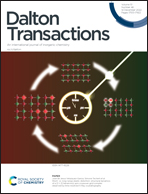Bulky ligands protect molecular ruby from oxygen quenching†
Abstract
Chromium(III) complexes can show phosphorescence from the spin-flip excited doublet states 2E/2T1 in the near-infrared with high photoluminescence quantum yields and extremely long lifetimes in the absence of dioxygen. The prototype molecular ruby, [Cr(ddpd)2]3+ (ddpd = N,N′-dimethyl-N,N′-dipyridine-2-ylpyridine-2,6-diamine), has a photoluminescence quantum yield and a luminescence lifetime of 13.7% and 1.1 ms in deaerated acetonitrile, respectively. However, its luminescence is strongly quenched by 3O2via an efficient Dexter-type energy transfer process. To enable luminescence applications of molecular rubies in solution under aerobic conditions, we explored the potential of sterically demanding ddpd ligands to shield the chromium(III) center from O2 using steady state and time-resolved photoluminescence spectroscopy. The structures of the novel complexes with sterically demanding ligands were investigated by single crystal X-ray diffraction and quantum chemically by density functional theory calculations. The O2 sensitivity of the photoluminescence was derived from absolutely measured photoluminescence quantum yields and excited state lifetimes under inert and aerobic conditions and by Stern–Volmer analyses of these data. Optimal sterically shielded chromium(III) complexes revealed photoluminescence quantum yields of up to 5.1% and excited state lifetimes of 518 µs in air-saturated acetonitrile, underlining the large potential of this ligand design approach to broaden the applicability of highly emissive chromium(III) complexes.



 Please wait while we load your content...
Please wait while we load your content...